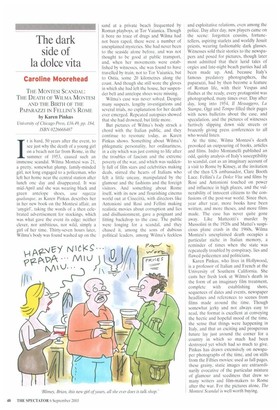The dark side of la dolce vita
Caroline Moorehead
THE MONTES1 SCANDAL: THE DEATH OF WILMA MONTESI AND THE BIRTH OF THE PAPARAZZI IN FELLINI'S ROME by Karen Pinkus University of Chicago Press, £16.49, pp. 184, ISBN 0226668487 1 t is hard, 50 years after the event, to see just why the death of a young girl on a beach not far from Rome, in the summer of 1953, caused such an immense scandal. Wilma Montesi was 21, a pretty, somewhat plump, family-minded girl, not long engaged to a policeman, who left her home near the central station after lunch one day and disappeared. It was mid-April and she was wearing black and green antelope shoes, una ragazza qualunque, as Karen Pinkus describes her in her new book on the Montesi affair, an `anygirr, taking the words of a then celebrated advertisement for stockings, which was what gave the event its edge: neither clever, nor ambitious, nor wild, simply a girl of her time. Thirty-seven hours later, Wilma's body was found washed up on the
sand at a private beach frequented by Roman playboys. at Tor Vaianica. Though it bore no trace of drugs and Wilma had not been raped, there were a number of unexplained mysteries. She had never been to the seaside alone before, and was not thought to be good at public transport, and, when her movements were established by witnesses, she was found to have travelled by train, not to Tor Vaianica, but to Ostia, some 20 kilometres along the coast. And though she still wore the gloves in which she had left the house, her suspender belt and antelope shoes were missing.
Wilma's case was never solved. Despite many suspects, lengthy investigations and several trials, no explanation for her death ever emerged. Repeated autopsies showed that she had drowned, but little more.
But pictures of Wilma's body struck a chord with the Italian public, and they continue to resonate today, as Karen Pinkus shows. Something about Wilma's phlegmatic personality, her ordinariness, in a city which was just coming to life after the troubles of fascism and the extreme poverty of the war, and which was suddenly full of film stars and celebrities making deals, stirred the hearts of Italians who felt a little uneasy, manipulated by the glamour and the fashions and the foreign visitors. And something about Rome itself, with its new and flourishing cinema world out at Cinecitta, with directors like Antonioni and Rosi and Fellini making realistic movies about corruption and lies and disillusionment, gave a poignant and fitting backdrop to the case. The public were longing for a scandal, and they chased it, among the sons of dubious political leaders, among Wilma's feckless and exploitative relations, even among the police. Day after day, new players came on the scene: forgotten cousins, fortunetellers, aspiring starlets and worldly Jesuit priests, wearing fashionable dark glasses. Witnesses sold their stories to the newspapers and posed for pictures, though later most admitted that their lurid tales of orgies and late-night beach parties had all been made up. And, because Italy's famous predatory photographers, the paparazzi, had by then become a feature of Roman life, with their Vespas and flashes at the ready, every protagonist was photographed, many times over. Day after day, long into 1954, II Messaggero, La Stampa, Oggi and Tempo filled their pages with news bulletins about the case, and speculation, and the pictures of witnesses furtively slipping down side streets or brazenly giving press conferences to all who would listen.
At the time, Wilma Montesi's death provoked an outpouring of books, articles and films. Indro Montanelli published an odd, quirky analysis of Italy's susceptibility to scandal, cast as an imaginary account of a visit to Rome by Kinsey, at the invitation of the then US ambassador, Clare Booth Luce. Fellini's La Dolce Vita and films by Rosi and Antonioni touched on power and influence in high places, and the vulnerability of innocent citizens to the confusions of the post-war world. Since then, year after year, more books have been written, and more theses, and more films made. The case has never quite gone away. Like Matteotti's murder by Mussolini in the 1920s and Mattei's suspicious plane crash in the 1960s, Wilma Montesi's unexplained death occupies a particular niche in Italian memory, a reminder of times when the state was repeatedly troubled by conspiracy, lies and flawed policemen and politicians.
Karen Pinkus, who lives in Hollywood, is a professor of Italian and French at the University of Southern California. She casts her fresh look at Wilma's death in the form of an imaginary film treatment, complete with establishing shots, equences of dates and events, newspaper headlines and references to scenes from films made around the time. Though somewhat jerky and not always easy to read, the format is excellent at conveying the hectic and hopeful mood of the time, the sense that things were happening in Italy, and that an exciting and prosperous future lay just around the corner for a country in which so much had been destroyed yet which had so much to give. Pinkus has drawn extensively on newspaper photographs of the time, and on stills from the Fifties movies: used as full pages, these grainy, static images are extraordinarily evocative of the particular mixture of glamour and seediness that drew so many writers and film-makers to Rome after the war. For the pictures alone, The Montesi Scandal is well worth buying.










































































 Previous page
Previous page